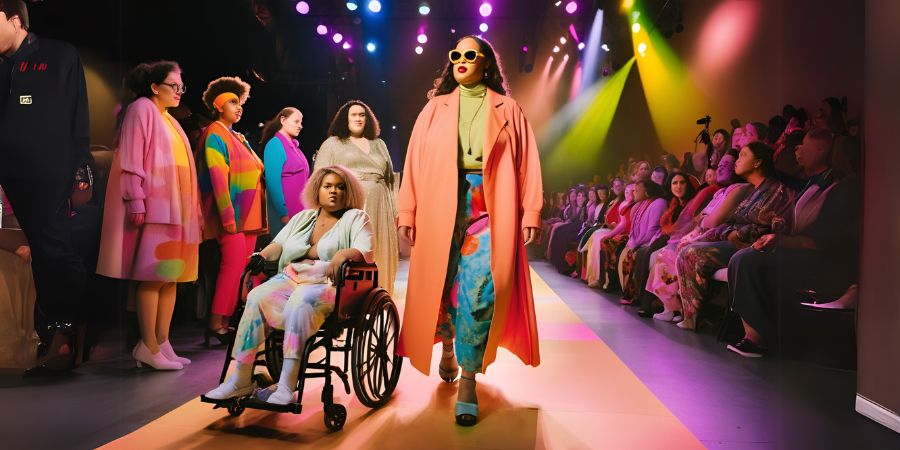Fashion for People with Disabilities
In recent years, the call for inclusivity in various industries has grown louder, with fashion being no exception. While traditionally associated with style and self-expression, fashion has a deeper role to play in ensuring accessibility and empowerment for individuals across all walks of life. For people with disabilities, clothing often goes beyond aesthetics, intertwining with functionality and comfort to address unique needs.
Thesis Statement: Adaptive fashion—a burgeoning segment of the industry—caters specifically to individuals with disabilities, focusing on style, comfort, and functionality, yet remains an area requiring greater attention and innovation.
The global prevalence of disabilities underscores the urgency of this discussion. According to the World Health Organization (WHO), over one billion people worldwide experience some form of disability. Despite this significant demographic, mainstream fashion often overlooks their needs, leaving a gap in representation and accessibility that adaptive fashion seeks to fill.
Understanding Adaptive Fashion
1. Definition and Importance
Adaptive fashion refers to clothing, footwear, and accessories designed to accommodate the needs of individuals with disabilities or physical limitations. This includes garments tailored for ease of dressing, mobility support, and sensory-friendly features. Adaptive fashion matters because it empowers individuals, enhances their quality of life, and fosters inclusivity within society.
2. Challenges in Traditional Fashion
Mainstream clothing often prioritizes aesthetics over accessibility. For individuals with disabilities, this can result in garments that are difficult to wear, uncomfortable, or even unsafe. For example, clothing with small buttons or tight fits may pose challenges for individuals with limited dexterity or mobility.
3. Benefits of Inclusive Design
Adaptive fashion addresses these gaps by prioritizing user-friendly designs without compromising on style. Such clothing can boost confidence, promote independence, and challenge societal stereotypes about disability. Moreover, inclusive design paves the way for broader societal acceptance, emphasizing that fashion should be for everyone.
Key Features of Adaptive Fashion
1. Ease of Dressing
Adaptive fashion incorporates features like magnetic closures, Velcro fastenings, and elasticized fabrics to simplify the process of dressing. These modifications benefit individuals with limited hand mobility or those requiring assistance from caregivers.
2. Mobility Considerations
For wheelchair users or individuals with prosthetics, adaptive clothing often includes features such as higher back rises, reinforced seams, or strategically placed zippers. These elements ensure comfort and practicality while seated or navigating mobility aids.
3. Sensory-Friendly Materials
For those with sensory sensitivities, adaptive fashion employs soft, non-irritating fabrics. Seamless designs, tag-free labels, and breathable materials reduce discomfort and make wearing the garments a pleasant experience.
4. Customizable and Functional Design
Adjustable waistbands, removable layers, and flexible sizing options cater to diverse needs and body types. These designs provide individuals with a sense of autonomy, allowing them to personalize their clothing to their preferences and requirements.
Challenges Faced by the Adaptive Fashion Industry
1. Limited Awareness
One of the primary barriers to the growth of adaptive fashion is the lack of visibility and understanding. Many consumers and brands remain unaware of the specific needs of individuals with disabilities, perpetuating the cycle of exclusion.
2. Higher Costs
Adaptive clothing often comes with a higher price tag due to the specialized designs, materials, and production processes involved. This cost disparity can make such clothing inaccessible for many.
3. Design Barriers
Striking a balance between functionality and aesthetics is a significant challenge for designers. While adaptive clothing must meet specific practical needs, it must also appeal to the individual’s sense of style and self-expression.
4. Retail Gaps
Despite growing demand, adaptive clothing is not widely available in mainstream stores. Limited retail presence forces consumers to rely on niche brands or online platforms, restricting access and choice.
Emerging Trends in Adaptive Fashion
1. Technological Innovations
Advances in technology are revolutionizing adaptive fashion. Smart textiles, for instance, can monitor health metrics or adjust to temperature changes, enhancing both functionality and comfort. 3D printing offers opportunities for custom-fit garments, reducing waste and improving accessibility.
2. Collaborations and Advocacy
Brands are increasingly partnering with disability advocates and organizations to design clothing that genuinely addresses users’ needs. These collaborations not only improve product quality but also raise awareness about adaptive fashion.
3. Runway Representation
Adaptive fashion is gaining visibility on major platforms, with models with disabilities gracing runways at high-profile fashion shows. This representation challenges traditional beauty standards and celebrates diversity.
4. Sustainability in Adaptive Wear
Sustainability is becoming a key focus in adaptive fashion. Eco-friendly materials and ethical production processes are being integrated to create clothing that is both inclusive and environmentally responsible.
Brands Leading the Way
1. Mainstream Brands
Brands like Tommy Hilfiger Adaptive and Zappos Adaptive have pioneered efforts to incorporate adaptive lines into their collections. These initiatives demonstrate that inclusivity can align with mainstream fashion values and reach a broader audience.
2. Boutique and Specialist Brands
Smaller brands such as MagnaReady and IZ Adaptive specialize in adaptive clothing, offering innovative solutions tailored to specific needs. These boutique brands often lead the way in design innovation and user-centric approaches.
3. Case Studies
Stories of individuals benefiting from adaptive fashion highlight its transformative potential. For example, a wheelchair user finding stylish yet functional jeans can experience a renewed sense of confidence and independence.
Practical Tips for Designing Adaptive Fashion
1. User-Centered Design
Involving individuals with disabilities in the design process ensures that adaptive clothing meets real-world needs. User feedback can guide improvements and foster trust between brands and consumers.
2. Balancing Style and Functionality
Designers should prioritize both aesthetics and practicality, ensuring that adaptive clothing is stylish without compromising on essential features. Collaboration with fashion experts and disability advocates can help achieve this balance.
3. Affordable Solutions
To reduce costs, brands can explore scalable production methods, partnerships with nonprofit organizations, or government subsidies. Affordability ensures that adaptive fashion is accessible to a wider audience.
How Consumers Can Support Adaptive Fashion
1. Promoting Awareness
Consumers can raise awareness by sharing information about adaptive fashion on social media, participating in campaigns, and celebrating inclusive brands.
2. Providing Feedback
Engaging with brands and providing constructive feedback can help improve adaptive clothing lines. Consumers’ voices are instrumental in driving innovation and inclusivity.
3. Advocating for Inclusivity
Pushing for greater representation in fashion campaigns and retail spaces can encourage more brands to prioritize adaptive fashion. Advocacy efforts highlight the importance of inclusion as a standard practice rather than an exception.
Conclusion
1. Summary of Key Points
Adaptive fashion is a vital segment of the fashion industry, addressing the needs of individuals with disabilities while promoting inclusivity and empowerment. Its focus on ease of dressing, mobility, sensory-friendly materials, and customizable designs enhances quality of life and challenges societal norms.
2. Call to Action
As consumers, designers, and advocates, we must collectively support adaptive fashion by raising awareness, demanding representation, and championing innovation. By prioritizing inclusivity, we can transform fashion into a tool for empowerment.
3. Inspirational Note
Adaptive fashion is not just about clothing; it is about dignity, confidence, and self-expression. By embracing this movement, we take a step toward a more inclusive society where everyone can celebrate their unique identity with pride.


